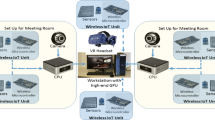Abstract
Pig weights are important indicator for the healthcare and the economic operation of pig farms, and the development of a system to easily estimate these weights is desired. Although load cells are usually used for actual measurement in pig farms, it is not easy to guide pigs weighing more than 100 kg to the scales because many pigs do not like to get on the scales. Therefore, a convenient pig weight estimation system using RGB-D sensors has been developed. An RGB-D sensor (Intel Realsense D455) is used as the sensing device for weight estimation. Weight estimation is performed on 3D point cloud data of photographed pig images. When capturing pigs, it is desirable to have a constant camera orientation toward the pigs However, it is not easy to always capture from the same direction because pigs move around quickly in the piggery. A method with a high degree of freedom in the capture direction by exploiting pig symmetry of the pig’s body is introduced in this paper. The system is applied for a wearing device using AR (Augmented Reality) glasses. Experimental results show the feasibility of this system.










Similar content being viewed by others
Data availability
The datasets generated during the current study are available from the corresponding author on reasonable request.
References
Dal Mutto C, Zanuttigh P, Cartelazzo GM (2012) Time-of-flight cameras and microsoft kinect. SpringerBriefs in Electr Comput Eng. https://doi.org/10.1007/978-1-4614-3807-6
Zhang Z (2012) Microsoft kinect sensor and its effect. IEEE Multimedia 19(2):4–10
Doeschl-Wilson AB, Whittemore CT, Knap PW et al (2004) Using visual image analysis to describe pig growth in terms of size and shape. Anim Sci 79(3):415–427
Brandl N, Jorgensen E (1996) Determination of live weight of pigs from dimensions measured using image analysis. Comput Electron Agric 15(1):57–72
Kashiha M, Bahr C, Ott S et al (2014) Weight estimation of pigs using top-view image processing. In: Campilho A, Kamel M (eds) Image analysis and recognition, vol 8814. ICIAR. Lecture notes in computer science. Springer, Cham, pp 496–503
Wang Y, Yang W, Winter P et al (2008) Walk-through weighing of pigs using machine vision and an artificial neural network. Biosyst Eng 100(1):117–125
Yoshida K, Kawasue K (2019) Robust 3D pig measurement in pig farm. In: 15th European conference on computer vision, ECCV 2018. Lecture notes in computer science, vol 11129. LNCS, p 387–400
Win KD, Kawasue K, Yoshida K (2020) Extraction of pig outline and estimation of body weight by detection of multiple lines structured light using discrete Fourier transform. EAEF 13(3):81–88
Guo H, Wang K, Su W et al (2017) 3D scanning of live pigs system and its application in body measurements. Int Arch Photogram Remote Sens Spa Inf Sci 42(2):211–217
Win KD, Kawasue K, Yoshida K et al (2021) Automatic pig selection system based on body size using a camera: rotating mechanics for pig selection. Artif Life Robot 26(2):155–161
Syberfeldt A, Danielsson O, Gustavsson P (2017) Augmented reality smart glasses in the smart factory: product evaluation guidelines and review of available products. IEEE Access 5:9118–9130
Kawasue K (2021) Weight estimation device and program. PCT/JP2021/005666(WO/2021/166894)
Jollife IT, Cadima J (2016) Principal component analysis: a review and recent developments. Philos Trans R Soc A Math Phys Eng Sci 374(2065):20150202
Mishra SP, Sarkar U, Taraphder S et al (2017) Multivariate statistical data analysis—principal component analysis (PCA). Int J Livest Res. https://doi.org/10.5455/ijlr.20170415115235
Garcia A, Escolano S et al (2018) A survey on deep learning techniques for image and video semantic segmentation. Appl Soft Comput 70:41–65
Redmon J, Divvala S, Girshick R et al (2016) You only look once: unified, real-time object detection. In: Proceeding of the IEEE computer society conference on computer vision and pattern recognition, 2016-December, 7780460, p 779–788
Jocher G, Chaurasia A, Stoken A et al (2021) ultralytics/yolov5: v6.0 - YOLOv5n ‘Nano’ models, Roboflow integration, TensorFlow export, OpenCV DNN support. 10.5281/zenodo.5563715
Rother C, Kolmogorov V, Blake A (2004) GrabCut—interactive foreground extraction using iterated graph cuts. ACM SIGGRAPH 2004 Papers. SIGGRAPH 2004:309–314
Peng B, Zhang L, Yang J (2010) Iterated graph cuts for image segmentation, vol 5995. Lecture notes in computer science LNCS (PART 2). Springer, Berlin, p 677–686
Breiman L (2001) Random forests. Mach Learn 45(1):5–32
Overview of Pork Carcass Trade Standards (in Japanese), Japan Meat Grading Association (2018)
Acknowledgements
All animal experiments were conducted in compliance with the protocol which was reviewed by the Institutional Animal Care and Use Committee and approved by the President of University of Miyazaki (Permit Number: 2017-021). This work was partially supported by JSPS KAKENHI Grant Number 20H03108. The staff of FEED ONE co. (Japan) and Big Dutchman (Germany) performed a great deal of work in collecting the training data and evaluating the device, and we thank them for their practical advice. We would like to express our gratitude to them.
Author information
Authors and Affiliations
Corresponding author
Additional information
Publisher's Note
Springer Nature remains neutral with regard to jurisdictional claims in published maps and institutional affiliations.
This work was submitted and accepted for the Journal Track of the joint symposium of the 28th International Symposium on Artificial Life and Robotics, the 8th International Symposium on BioComplexity, and the 6th International Symposium on Swarm Behavior and Bio-Inspired Robotics (Beppu, Oita, January 25–27, 2023).
About this article
Cite this article
Kawasue, K., Wai, P.P., Win, K.D. et al. Pig weight prediction system using RGB-D sensor and AR glasses: analysis method with free camera capture direction. Artif Life Robotics 28, 89–95 (2023). https://doi.org/10.1007/s10015-022-00827-x
Received:
Accepted:
Published:
Issue Date:
DOI: https://doi.org/10.1007/s10015-022-00827-x




